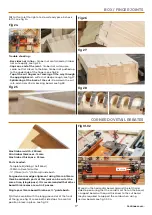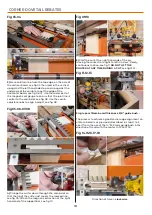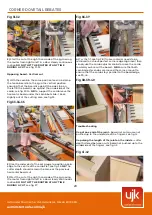
BOX / FINGER JOINTS
CORNER DOVETAIL REBATES
17
Fig 24
10)
Cut from left to right at a slow steady pace & check
for fit, see fig 24
Trouble shooting -
• Box sides not in line -
timber not centralised or timber
not cut equally, see fig 25.
• Gaps one end of the joint -
timber not cut square,
comb not flat & level to the base, timber not pushed up
to the underside of the fingers, see fig 26.
• Top of the cut fingers not coming all the way through
the oppsing board -
cutter not deep enough, see fig 27.
• Splintering at the back of the cut -
slow down the cut
rate, add in sacrificial backing board, see fig 28.
Max timber width - 290mm
Min timber thickness - 12mm
Max timber thickness - 25mm
Parts needed -
• Template B (sliding / half blind)
• 13.55mm Dovetail cutter
• ¾" (19mm) or ⅝" (15.9mm) Guide bush
For good corner edge alignment using 12mm & 15mm
thick boards both parts of this joint can be cut at the
same time, (single pass). It is recommended that other
board thicknesses are cut in 2 passes.
1)
Attach comb B with the long groove slot at the front
of the jig, see fig 01, move both side stops to a central
position & lock in place, see fig 02.
Single pass 12mm board thickness, ¾" guide bush -
Fig 01-02
Fig 26
Fig 27
Fig 25
Fig 28
2)
Load in the horizontal board. Against the left hand
side stop ensuring that the comb is sat flat on the board,
a support board with equal thickness to the cut board
may be required to support the comb when using
narrow boards, see fig 03-04.
Continues over...
Side Stop




































